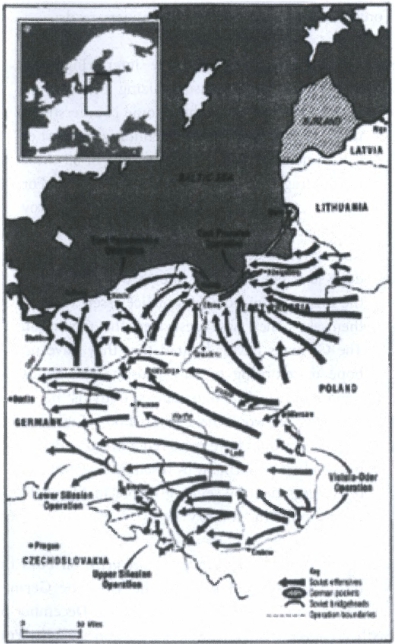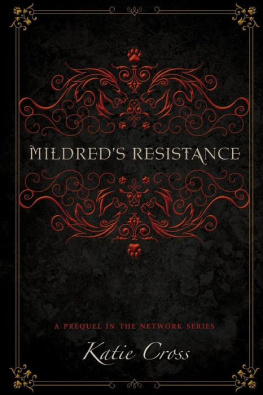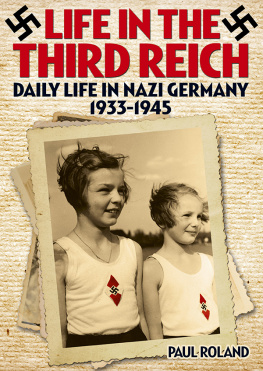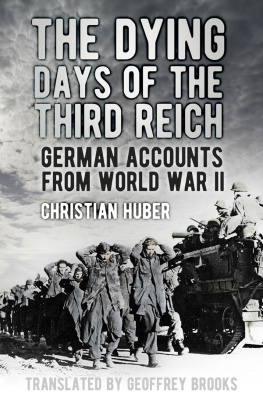FALLEN EAGLE
The Last Days of the Third Reich
Robin Cross
First published by Michael OMara in 1995
Copyright Robin Cross 1995, 2015
This edition published in 2020 by Lume Books
30 Great Guildford Street,
Borough, SE1 0HS
The right of Robin Cross to be identified as the author of this work has been asserted by them in accordance with the Copyright, Design and Patents Act, 1988.
All rights reserved. No part of this publication may be reproduced, stored in a retrieval system, or transmitted in photocopying, recording or otherwise, without the prior permission of the copyright owner.
A few friends came round yesterday evening. At 8 oclock we had the usual raid, which left a lot of broken windows as a New Years greeting. At midnight all was still. We stood with raised glasses, hardly daring to clink them together. A single bell tinkled in the distance for the passing of the year, and we heard shots, and heavy boots crunching on the splintered glass. It was eerie, as though a shadow were passing over us and touching us with its dark wings.
Ursula von Kardorff, 1 January 1945
Table of Contents
C hapter O ne
LOST VICTORIES
Never in my life have I accepted the idea of surrender, and I am one of those men who have worked their way up from nothing. Our present situation, therefore, is nothing new to me. Once upon a time my own situation was entirely different, and far worse. I say this only so that you can grasp why I pursue my goal with such fanaticism and why nothing can wear me down. No matter how much I might be tormented by worries, even if my health were shaken by them that would still have not the slightest effect on my decision to fight on.
Adolf Hitler, 28 December 1944
In the last week of August 1914, in East Prussia, General Paul von Hindenburg and Major-General Erich Ludendorff encircled and destroyed the Russian Second Army. At the Battle of Tannenberg they won one of the most complete victories in military history. Russian captives totalled 125,000 and the unknown number of dead included Second Armys commander, General Alexander Samsonov, who wandered into a forest and shot himself. The Battle of Tannenberg cleared German territory of Russian troops for the duration of the First World War. Later a great monument was raised at Tannenberg, and Hindenburg and his wife were buried there.
In January 1945 the Russians were back in East Prussia. This time it was defended by Colonel-General Hans Reinhardts Army Group Centre, fielding approximately 600,000 men, 700 tanks, 800 artillery pieces and 1,300 aircraft. Facing Reinhardts command was the combined might of General Ivan Bagramyans First Baltic Front, General Ivan Chernyakhov-skys Third Belorussian Front and Marshal Konstantin Rokossovskys Second Belorussian Front. Between them the three fronts could put into the field 1.7 million men, 28,000 artillery pieces, 3,300 tanks and 10,000 aircraft, a measure of crushing Soviet material superiority. There would be no repeat of Tannenberg.
Time was running out for the monument to the victor of Tannenberg. On 21 January Rokossovskys Second Belorussian Front took Tannenberg. The retreating Germans had dynamited the monument and removed the remains of Hindenburg and his wife and the colours of the regiments he commanded.
An overview of Soviet operations, JanuaryApril, 1945.
News of the destruction of Hindenburgs tomb filtered back to Berlin, where it was noted in the diary kept by Hans-Georg von Studnitz, a thirty-eight-year-old official in the information and press section of the German Foreign Ministry. His entry for 25 January reads:
The streams of refugees are interfering with military operations, disorganizing the lines of communication from which some counterstroke might be launched, and are denuding the East of its German population. In the midst of all these terrible tragedies childish actions still abound. For example, German troops were ordered to destroy the Tannenberg memorial, in order to prevent the Russians from demolishing it. Whether they have done so or not, God only knows. But in any case, the Russians can now with justice assert that, by themselves they have destroyed the memorial. The Germans have admitted that they have no hope of returning to East Prussia. The goods wagon in which Hindenburgs body is being brought back would have carried 60 refugees to safety. We would have rendered a greater service to the future of Germany by rescuing that number of refugees than by sending the Field Marshals corpse round the country.
Germanys future looked increasingly grim on both the Western and Eastern Fronts. In the West the German offensive launched in the Ardennes on 16 December by Sixth SS Panzer and Fifth Panzer Armies and Seventh Army had been contained and then rolled back by the Americans and British. By 16 January 1945 the bulge which had been driven sixty miles into the fifty-mile front held by General Courtney Hodgess US First Army had been eliminated. The fog which had grounded Allied aircraft at the start of the offensive had lifted, enabling fighter-bombers to strafe German traffic routes and supply convoys. The roads on which the Germans withdrew were soon littered with the blackened hulks of Hitlers armoured reserve. The German losses of 800 tanks were irreplaceable. The Allies made good similar losses in two weeks.
On the Eastern Front, Germanys strategic position had been reduced to ruins by the destruction of Army Group Centre in July-August 1944. At the turn of the year the remnants of Army Group Centre, redesignated Army Group A, held a line along the River Vistula less than 400 miles from Berlin, the flat expanse of the Polish plain at their backs and no obstacle but the River Oder between them and the capital of the Reich. Two Red Army fronts, Marshal I.S. Konevs First Ukrainian and Marshal Georgi K. Zhukovs First Belorussian, had been ordered to advance across western Poland and into Germany. Both commanders enjoyed an overwhelming material superiority over the enemy and were now displaying a new mastery of mechanized warfare. Konev opened his offensive on 12 January and Zhukov followed two days later. Within forty-eight hours they had broken through the crust of the German tactical defence zone and their armoured formations were moving at speed across open country. To the north the Soviet drive to the Baltic, spearheaded by Third Belorussian and Second Belorussian Fronts, sent millions of refugees fleeing westward to the Reich or northward to the Baltic ports.
On the southern sector of the Eastern Front the situation was equally grave. In August 1944 Romanian guerrillas had staged an armed rebellion in Bucharest, taken control of the city, arrested the puppet dictator Marshal Ion Antonescu and overthrown the government. King Michael had then formed a new government, negotiated an armistice with the Allies and declared war on Germany. By the end of August most of the German occupying forces had left Romania, and on the 30th Soviet troops entered Bucharest without meeting any armed resistance.
Hitlers Balkan strategy was falling apart in his hands. The German occupation of Greece had been fatally undermined by the capitulation of Italy in September 1943. Just over a year later, on 12 October 1944, German Army Group E began a fighting withdrawal from Greece to link up with Army Group F in Yugoslavia.
There were some crumbs of comfort for Adolf Hitler as he surveyed his war maps. North of the Carpathians, Army Group South, which had narrowly escaped destruction in August 1944, was now close to holding its own in Hungary. Budapest, which had been encircled by Russian forces at the end of December 1944, might still be relieved. In Italy Army Group C had halted British Eighth and American Fifth Armies at the Gothic Line, a string of heavily fortified positions stretching from south of La Spezia, on Italys western coast, to a point on the Adriatic between Pesaro and Cattolica.
















